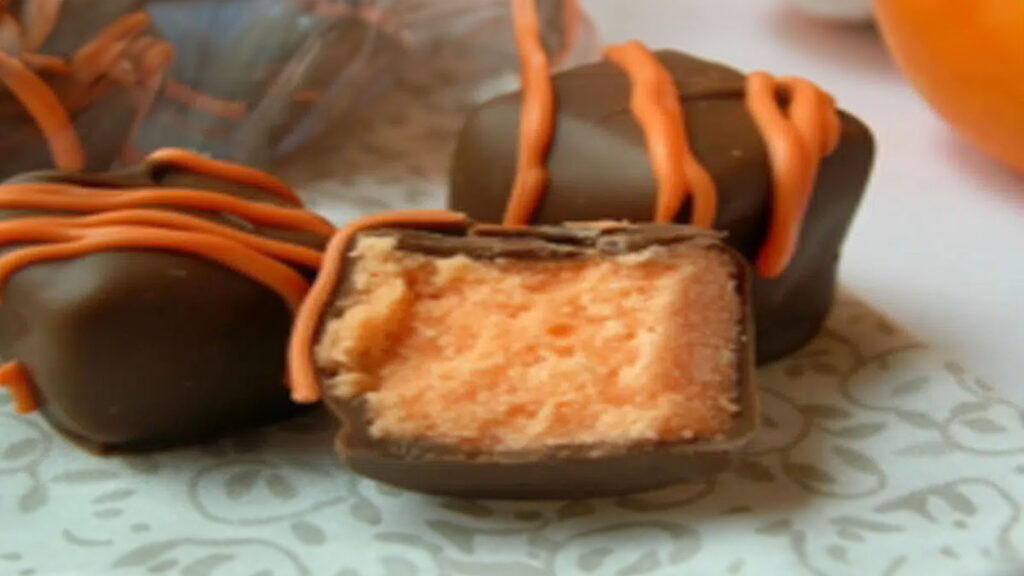
Tempering chocolate is one of those things that is scary to even think about. But if you know a little chocolate science (which we’ll address) and follow our instructions, we can almost guarantee chocolate tempering success for you. We say almost because there are sooo many factors that affect chocolate. But don’t get overwhelmed. It really isn’t hard.
Okay, so let’s begin with what tempered chocolate looks like…
The first thing you notice is the appearance. It has a smooth. shiny surface. It should be crisp and snap when you bite it. No crumbly-ness.
Now for the science-y part. We’ll try not to get too technical, but know that understanding the chemistry of chocolate makes it easier to temper simply because you know what you’re trying to achieve with each step.
Here we go..we’ll try not to lose you.
Chocolate is a crystalline substance made up of 6 different crystals. The tricky thing is that of these 6 crystals, only one creates the texture and appearance we want. This crystal is called beta V. (We’re only going to talk about 5 of the crystals, though. Beta VI is still a mystery to us and doesn’t really seem to play a major role in tempering.)
Since the goal here is tempered chocolate, we need to take some more steps. We need to re-melt all but the beta V crystals and get them to align. It’s really not as complicated as it sounds. It’s all about watching the temperature of the chocolate.
So, the melted chocolate has cooled to 80 – 82 F. Wait…back up. How do we cool the chocolate? You could let it sit, stirring often. That would do the trick, but it takes forever. What we do is add some unmelted chocolate. After chopping your chocolate, only melt about 2/3 of it. The remaining 1/3 will be your “seed” chocolate – the chocolate you add to cool it.
Nobody’s lost yet, right?
Okay. Slowly bring the heat back up. Get yourself a good chocolate thermometer and watch the temperature. You want to bring it back up to 86 – 88 F.
The previous four images are illustrating what’s happening as the temperature rise
s. Once you get to 88 F (no higher than 89 F), take the chocolate off the heat and STIR. Stir, stir, stir. Chocolate LOVES to be stirred. The beta V crystals will begin to form around the seed chocolate and align in the pattern we want.
Bingo.
Go ahead and dip your chocolates. Now, your chocolate may begin to cool as you’re dipping, making it thick and difficult to work with. If this happens, VERY gently add some heat to the chocolate. But be very careful not to get it above 89 F. Your temper will be ruined if you do. However, not all is lost if you get it too hot. All that’s happened is that you’ve melted the beta V crystals. Just temper it again and keep going.
Simple enough, right? Once you get the hang of it, anyway.
We were going to do some troubleshooting at this point, but this post is already long and there’s enough troubleshooting questions to make a whole other post. Stay tuned. Friday we’ll cover bloom, streaks, splotches, seizing, and more.
Do you have any questions? Do you need clarification on something? Ask in the comments section below.
(Our images are inspired by Chocolate Alchemy. Give them a visit for a more in-depth explanation.)
Save
Save

Kitchen Kneads is your one-stop shop for quality grains, flour, kitchen appliances, and other ingredients.
We are Utah’s premier baking and cooking resource!
Questions?


Kitchen Kneads is your one stop shop for quality grains, flour, kitchen appliances and other ingredients. We are Utah’s premiere baking and cooking resource! Questions?
888-881-9957
info@kitchenkneads.com
2022 | Kitchen Kneads | All Rights Reserved | Privacy Policy | Terms | XML Sitemap | Site by PDM